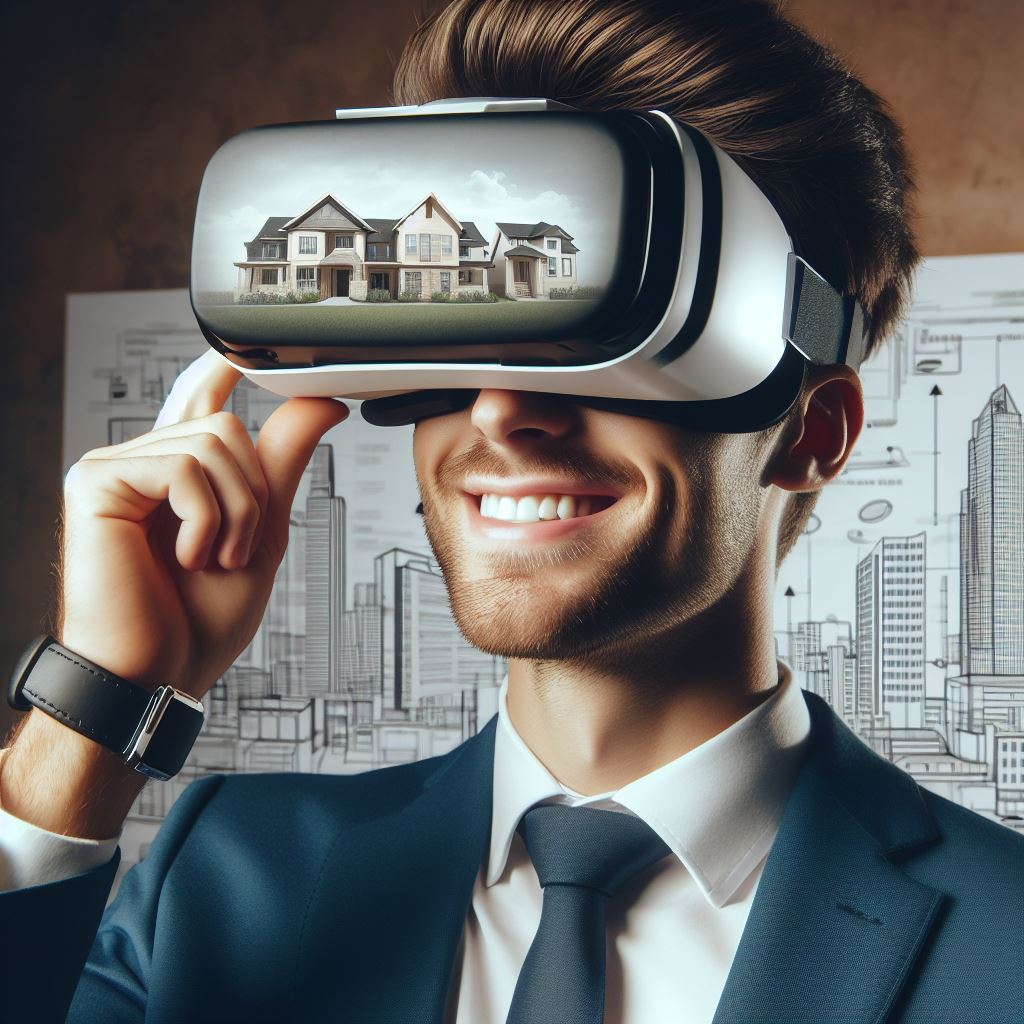Introduction
Virtual Reality (VR) has become increasingly prevalent in various industries, including property development.
This blog post aims to provide readers with a virtual tour of the role of VR in property development.
VR technology has seen rapid growth and adoption in many sectors, such as gaming, healthcare, and education.
Its immersive nature allows for an enhanced user experience and more effective communication.
The purpose of this blog post is to demonstrate how VR technology is revolutionizing property development.
Through a virtual tour, readers can explore the potential applications and benefits that VR offers in this industry.
With VR, potential property buyers can experience realistic walkthroughs and visualizations of properties that have not yet been constructed.
This technology provides a valuable tool for developers to showcase their projects and attract potential buyers.
Additionally, VR allows for easy customization and modifications to the property’s design.
Buyers can visualize different finishes, layouts, and furniture arrangements, helping them make informed decisions before investing.
Moreover, VR technology enables remote collaborations among architects, designers, and stakeholders.
They can virtually meet and review designs in real-time, improving communication and decision-making processes.
Furthermore, VR can be used for urban planning, allowing city officials and stakeholders to assess proposed developments’ impact accurately.
This immersive experience aids in urban design and ensures that potential challenges and opportunities are identified early on.
In essence, VR technology is revolutionizing the property development industry.
Through its immersive and interactive capabilities, developers can enhance the buying experience, streamline design processes, and make more informed decisions. Stay tuned for the virtual tour of VR in property development in the upcoming sections.
What is VR in Property Development?
A. VR (virtual reality) and its applications in the real estate sector
VR (virtual reality) in property development refers to the use of immersive technology to create digital simulations of real estate projects.
This technology allows developers to design, showcase, and sell properties in a more innovative and efficient way.
B. How VR is transforming the way property developers design, showcase, and sell their projects
Virtual reality has revolutionized the real estate sector in numerous ways:
- Enhanced Design Capabilities: VR enables property developers to create 3D models of their projects, allowing them to visualize and modify designs with ease.
This helps in identifying potential flaws and making necessary changes before actual construction. - Improved Showcasing: With VR, developers can provide virtual tours of properties, giving potential buyers an immersive experience without the need for physical visits.
Interested buyers can explore different rooms and spaces virtually, leading to more informed purchasing decisions. - Effective Marketing Tool: VR technology allows developers to create virtual walkthroughs and present their projects in a visually compelling manner.
This results in better marketing campaigns and increased interest from potential customers.
C. Benefits of using VR in property development, such as cost savings and enhanced customer experience
The use of VR in property development brings several benefits, including:
- Cost Savings: VR can significantly reduce the costs associated with physical model creation and marketing materials.
It eliminates the need for expensive showrooms, brochures, and other traditional marketing methods. - Time Efficiency: Virtual reality expedites the design process by providing real-time visualization and instant feedback.
Developers can quickly make adjustments and iterations, saving time and accelerating project timelines. - Enhanced Customer Experience: VR offers potential buyers a sense of presence and immersion by allowing them to explore properties in a realistic way.
This results in a more engaging and memorable experience, fostering positive brand association.
Additionally, VR can provide developers with valuable insights into customer preferences.
By analyzing user interactions within virtual spaces, developers can gather data on which features, layouts, or designs receive the most attention.
This information helps in making informed decisions and further improving the project’s market appeal.
In fact, VR has transformed the real estate industry by revolutionizing the way property developers design, showcase, and sell their projects.
The use of VR technology brings cost savings, time efficiency, and enhanced customer experiences.
With its ability to create immersive virtual environments, VR has become an invaluable tool for property developers seeking to stay ahead in a competitive market.
Read: Affordable Housing: New Strategies
Virtual Property Tours
Virtual Reality (VR) technology has revolutionized various industries, and property development is no exception.
It has opened up new possibilities for potential buyers and investors, allowing them to take virtual property tours from the comfort of their own homes.
The immersive nature of VR tours helps individuals visualize the property in intricate detail, providing an unparalleled experience.
Additionally, VR tours offer the convenience of exploring multiple properties without physically visiting each one. Let’s delve into these benefits further.
A. Virtual Property Tours: A Homebound Experience
Gone are the days when buyers had to physically visit properties to get a sense of their layout and ambiance.
With VR, potential buyers can now effortlessly take virtual property tours from the comfort of their own homes.
By simply putting on a VR headset, individuals can explore various properties and get a realistic sense of what it would be like to physically be there.
The immersive nature of VR tours provides an extraordinary homebound experience.
Users can freely roam around the property, allowing them to take in every aspect of the house.
They can walk through the rooms, admire the architecture, and even experience the surrounding outdoor areas.
This level of detail fosters a deep connection between the buyer and the property, enhancing the decision-making process.
B. Visualization Made Easy
VR tours offer potential buyers the ability to visualize the property in unparalleled detail.
Traditional property images and videos can only provide a limited perspective, often leaving buyers with questions and doubts.
VR, on the other hand, recreates the property in a three-dimensional space, allowing users to see every nook and cranny.
The immersive experience provided by VR tours aids buyers in making informed decisions.
They can examine the layout, gauge room sizes, and get a genuine feel for the property’s flow.
Additionally, VR technology enables potential buyers to customize the space virtually, making changes to furniture, wall colors, or even room configurations.
This level of flexibility helps individuals visualize their future home and ensures transparency in the buying process.
C. Unparalleled Convenience
One of the key advantages of VR tours is the convenience they offer. Buyers can explore multiple properties without the hassle of physically visiting each one.
This not only saves time and money but also provides the flexibility to view properties located in different cities or even countries.
VR tours eliminate the need for extensive travel, enabling potential buyers to narrow down their options efficiently.
They can explore different architectural styles, compare amenities, and evaluate property features – all without leaving their living room.
This convenience is particularly beneficial for international buyers or those with limited mobility, drastically expanding the pool of potential buyers.
Virtual property tours have transformed the way buyers approach property development.
The immersive and convenient nature of VR tours allows potential buyers and investors to explore properties from a distance, without compromising on the level of detail.
By providing a homebound experience and aiding visualization, VR technology has become a game-changer in the industry.
As VR continues to advance, it is certain that its impact on property development will only grow stronger.
Read: Luxury Renovations: Worth the Cost?
Virtual Property Staging
A. The concept of virtual property staging and how it is revolutionizing traditional staging methods
Virtual property staging is a cutting-edge concept that is revolutionizing the traditional staging methods used in property development.
By harnessing the power of virtual reality (VR), this innovative approach allows potential buyers to visualize and experience a property without the need for physically furnishing it.
Compared to physically furnishing properties, virtual staging offers a cost-effective alternative that still provides an immersive and realistic experience.
Traditional staging requires investing in furniture, decor, and professional stagers, which can be expensive and time-consuming.
However, with virtual staging, all that is needed is a digital rendering of the property and the use of VR technology.
B. Cost-effectiveness of virtual staging compared to physically furnishing properties
The cost-effectiveness of virtual staging is particularly beneficial for real estate developers who want to showcase multiple properties simultaneously.
Instead of furnishing each property individually, virtual staging allows developers to create virtual versions that can be easily customized and adapted to different layouts and designs.
C. The flexibility of virtual staging, enabling buyers to see various furniture and decor options with just a few clicks
One of the biggest advantages of virtual staging is the flexibility it offers to potential buyers.
With just a few clicks, buyers can visualize the property with different furniture arrangements, decor styles, and color schemes.
This flexibility allows buyers to explore various options and tailor the property to their personal preferences.
Virtual staging also eliminates the need for physical furniture storage and maintenance.
In traditional staging, furniture needs to be stored and maintained until the property is sold. This can be a hassle and an additional cost for property developers.
With virtual staging, furniture and decor exist only in the digital space, making it a convenient and cost-effective solution.
Another advantage of virtual property staging is its ability to showcase properties before they are built.
Through architectural renderings, developers can create virtual versions of properties that are still under construction.
This enables buyers to visualize the finished property and make informed decisions about purchasing off-plan.
Virtual staging also enables developers to reach a wider audience.
With the increasing popularity of VR technology, potential buyers can explore and experience properties remotely.
This eliminates the need for physical visits and allows buyers from different locations to engage with the property, increasing the chances of a sale.
In short, virtual property staging is revolutionizing traditional staging methods in property development.
It offers a cost-effective alternative to physically furnishing properties, providing flexibility for buyers to customize their virtual experience.
With the advancement of VR technology, virtual staging is set to become an essential tool in the real estate industry.
Read: Tech Trends in Green Building Today

VR for Architectural Design
Virtual Reality (VR) technology has revolutionized the property development industry by empowering developers to create more accurate and efficient architectural designs.
With VR, architects and designers are able to visualize spaces, test different materials, and make informed decisions, leading to significant time and cost savings.
Enhancing Architectural Design with VR
VR technology has proven to be an invaluable tool for property developers in the architectural design process.
By immersing themselves in a virtual environment, architects can gain a better understanding of how their design will be experienced by users.
Through VR, architects can accurately visualize spaces and explore various design options.
They can create virtual walkthroughs, allowing them to examine the dimensions, proportions, and aesthetics of different architectural elements.
This level of immersion provides a more realistic representation compared to traditional 2D drawings or physical models.
Moreover, VR enables architects to experiment with different materials virtually.
They can see how various textures, colors, and finishes interact with the overall design.
This allows them to make well-informed decisions about the use of materials, ensuring the desired visual impact and functionality are achieved.
Testing and Iterating Designs
Another advantage offered by VR in architectural design is the ability to test and iterate designs more efficiently.
Traditionally, architects had to rely on clients’ imaginations to grasp the concept and layout of a proposed design.
However, with VR, they can offer clients an immersive experience, enabling them to fully understand the space and provide more accurate feedback.
By creating virtual prototypes, architects can identify design flaws and make necessary adjustments early in the process.
This reduces the risk of costly modifications during the construction phase.
Additionally, VR allows architects to simulate lighting conditions, acoustics, and even human behavior within a space, leading to more accurate assessments and optimized designs.
Time and Cost Savings
An undeniable benefit of using VR in architectural design is the significant time and cost savings associated with the iterative design process.
Traditionally, physical mock-ups and models were time-consuming to create and modify.
VR eliminates the need for such physical iterations, as changes can be made digitally and experienced in real-time.
Furthermore, VR saves architects and developers from building full-scale prototypes, which can be costly and time-consuming.
By using VR, they can identify design flaws and make adjustments virtually, significantly reducing expenses and accelerating the design process.
In general, VR technology has empowered property developers to create more accurate and efficient architectural designs.
By enabling architects and designers to visualize spaces, test materials, and make informed decisions, VR has revolutionized the architectural design process.
Moreover, the time and cost savings associated with using VR for design iterations make it an invaluable tool for the industry.
As VR technology continues to evolve, its impact on property development will undoubtedly continue to grow.
Read: Green Spaces in Urban Development
VR for Buyer Customization
A. How VR allows buyers to customize their properties virtually before construction begins
In the world of property development, virtual reality (VR) has emerged as a game-changer.
With VR technology, buyers can now customize their properties virtually before construction even begins.
This has numerous advantages and benefits for buyers and developers alike.
B. Advantages of VR for buyer customization, such as previewing different layouts, materials, and color schemes
1. Ability to preview different layouts
One of the key advantages of VR for buyer customization is the ability to preview different layouts, materials, and color schemes.
Buyers can now visualize the end result of their property and make informed decisions about the various design elements.
This level of customization was previously limited to just imagination, but VR has brought it to life.
2. Walk through their future homes
By using VR, buyers can walk through their future homes, virtually experiencing every room and space.
They can experiment with different furniture arrangements, lighting options, and even test out different architectural designs.
This level of immersion not only adds excitement for buyers but also helps them envision their dream home more clearly.
3. Wake confident decisions
Moreover, VR helps buyers make confident decisions about their property purchase.
When buyers can see and experience how different design choices affect the overall look and feel of their property, they are more likely to make choices that align with their preferences.
This reduces the chances of regretting the purchase later on.
4. Minimizes the element of surprise
VR also minimizes the element of surprise. Buyers can review architectural plans in virtual reality, allowing them to identify any potential design flaws or modifications needed beforehand.
It provides an opportunity for buyers to work closely with developers to make necessary changes, ensuring the end result meets their expectations.
5. Cost-saving
Another advantage of VR for buyer customization is the cost-saving aspect.
Traditionally, making changes to a property after construction is costly and time-consuming.
However, with VR, buyers can experiment with different design options virtually, saving valuable time and money.
This enables buyers to create their ideal living space without the hassle and expense of physical alterations later on.
6. Customization possibilities
Furthermore, the customization possibilities offered by VR extend beyond just residential properties.
Commercial buyers can also benefit greatly from VR technology.
For example, retailers can use VR to visualize the layout of their store, experiment with shelving arrangements, and even test the visibility of signage.
This enables them to optimize their space for maximum customer engagement and sales potential.
In review, VR has revolutionized the way buyers customize their properties.
By allowing them to virtually design and experience their future homes or commercial spaces, VR empowers buyers to make confident decisions while minimizing potential regrets.
With the ability to preview different layouts, materials, and color schemes, VR enables buyers to create their dream spaces more efficiently, saving time and money in the process.
As VR technology continues to evolve, the possibilities for buyer customization will only expand further in the world of property development.
Challenges and Considerations
When it comes to integrating virtual reality (VR) technology into property development, there are several challenges that need to be addressed.
From high costs and technological barriers to choosing the right VR tools and platforms, property developers must carefully consider these factors for optimum results.
A. Potential Challenges in Implementing VR in Property Development
- High Costs: One of the primary challenges faced by property developers in implementing VR is the high financial investment required.
VR technology can be expensive, including the cost of hardware, software, and the expertise needed. - Technological Barriers: Another significant challenge is the rapidly evolving nature of VR technology itself.
Keeping up with the latest advancements and ensuring compatibility can be a daunting task for property developers. - Integration Issues: Integrating VR seamlessly into the property development process can be challenging.
It requires collaboration between architects, developers, designers, and VR experts to ensure a smooth experience for potential buyers. - User Experience: Providing a high-quality user experience is crucial for VR adoption in property development.
Developers need to create immersive and realistic environments to effectively showcase properties in virtual reality. - Training and Education: Property developers and their teams must invest time and resources in training and educating themselves about VR technology.
Understanding its capabilities and limitations is essential for effective implementation.
B. The Importance of Choosing the Right VR Tools and Platforms
Selecting the appropriate VR tools and platforms is vital for successful integration into property development.
Some key considerations include:
- Hardware Compatibility: Property developers need to ensure that their chosen VR tools and platforms are compatible with different types of hardware, such as VR headsets and controllers.
- Software Capabilities: The VR software used should have the necessary features to create immersive and interactive virtual property tours.
It should support realistic graphics, smooth navigation, and interactive elements. - Scalability: Property developers should consider the scalability of the VR tools and platforms chosen.
They need to accommodate future growth and technological advancements without significant disruption or additional investment. - Ease of Use: The chosen VR tools and platforms should be user-friendly, requiring minimal technical expertise to operate.
This ensures that the property development team can focus on creating exceptional virtual experiences rather than struggling with complex technology.
C. Adapting and Educating Potential Buyers
In addition to addressing the technical challenges, property developers need to adapt their strategies to educate potential buyers about VR technology and its benefits in the property development process.
This includes:
- Marketing and Communication: Property developers must effectively market and communicate the advantages of VR in property development.
They can leverage various channels, such as websites, social media, and presentations, to reach a wider audience. - Virtual Tours and Demonstrations: Organizing virtual tours and demonstrations allows potential buyers to experience the benefits of VR firsthand.
These experiences help them visualize spaces, understand layouts, and make informed decisions. - Educational Material: Property developers should create educational material, such as videos, tutorials, and FAQs, to educate potential buyers about VR technology.
This helps in dispelling any myths or misconceptions and building confidence in the technology. - Collaboration with Real Estate Agents: Property developers can collaborate with real estate agents to educate them about VR and how it can enhance their sales process.
Real estate agents can then educate and promote VR to potential buyers.
In a nutshell, implementing VR in property development comes with its fair share of challenges and considerations.
However, by carefully addressing cost concerns, technological barriers, and user experience, property developers can harness the power of virtual reality to revolutionize the industry and provide immersive experiences to potential buyers.
Conclusion
VR technology has the potential to revolutionize property development by enhancing experiences and improving efficiency.
Throughout this blog post, we have discussed several key points regarding VR in property development.
We explored how VR can provide immersive virtual tours, allowing buyers to experience properties without being physically present.
This not only saves time and money but also enables developers to reach a wider audience.
Moreover, VR offers developers the opportunity to visualize and experiment with architectural designs in a virtual environment.
This allows for better planning and decision-making, leading to more efficient construction processes.
The transformative potential of VR in property development cannot be understated.
It has the power to revolutionize how properties are bought, sold, and built.
By embracing VR technology, developers can enhance customer experiences and improve efficiency, ultimately leading to better outcomes for all parties involved.
Therefore, it is crucial for property developers and buyers to embrace VR technology.
By doing so, they can take advantage of the enhanced experiences and improved efficiency offered by VR, ultimately reaping the benefits of this transformative technology.




